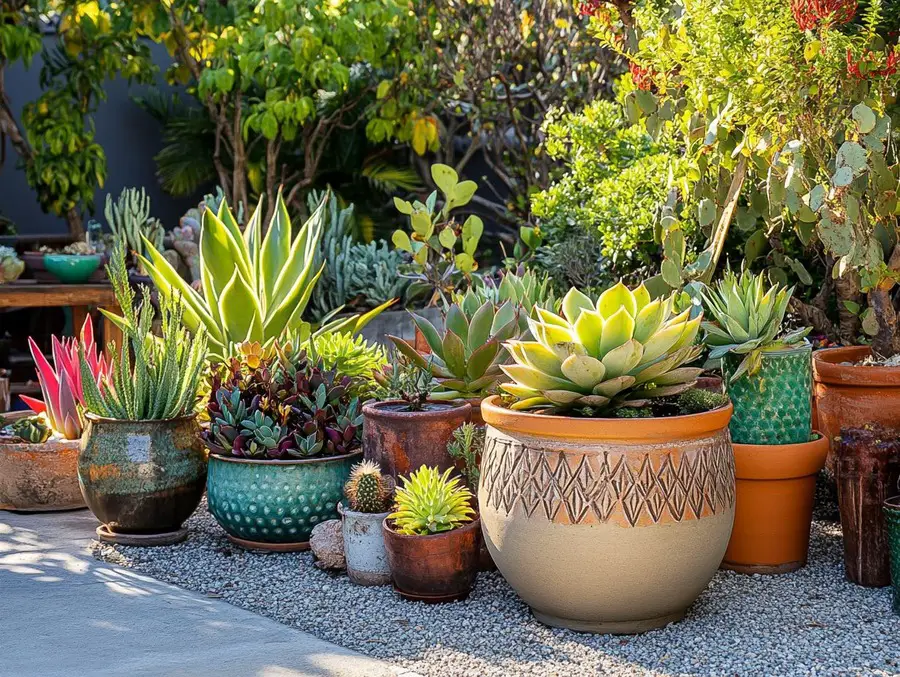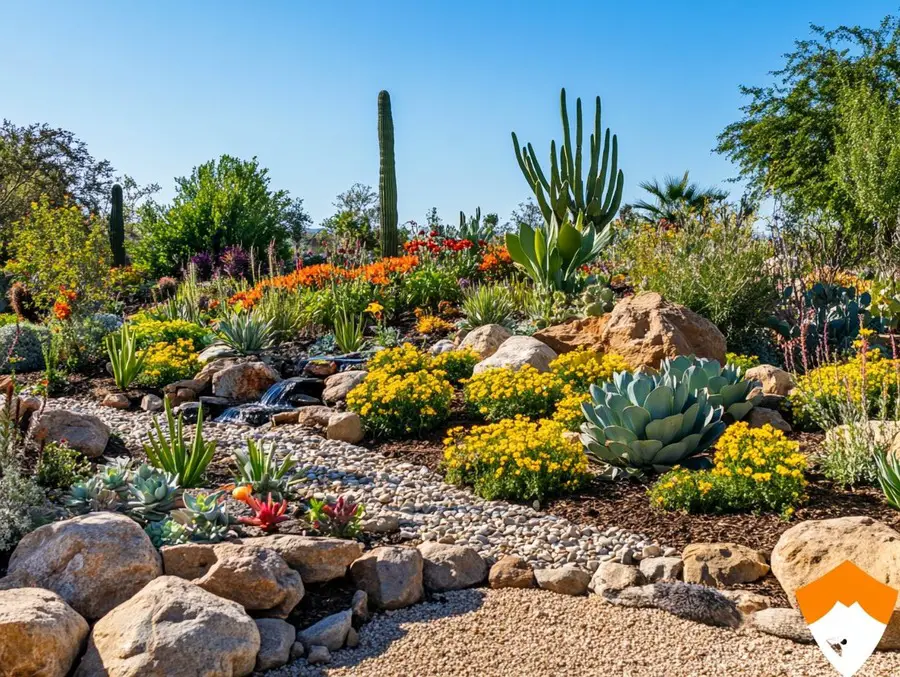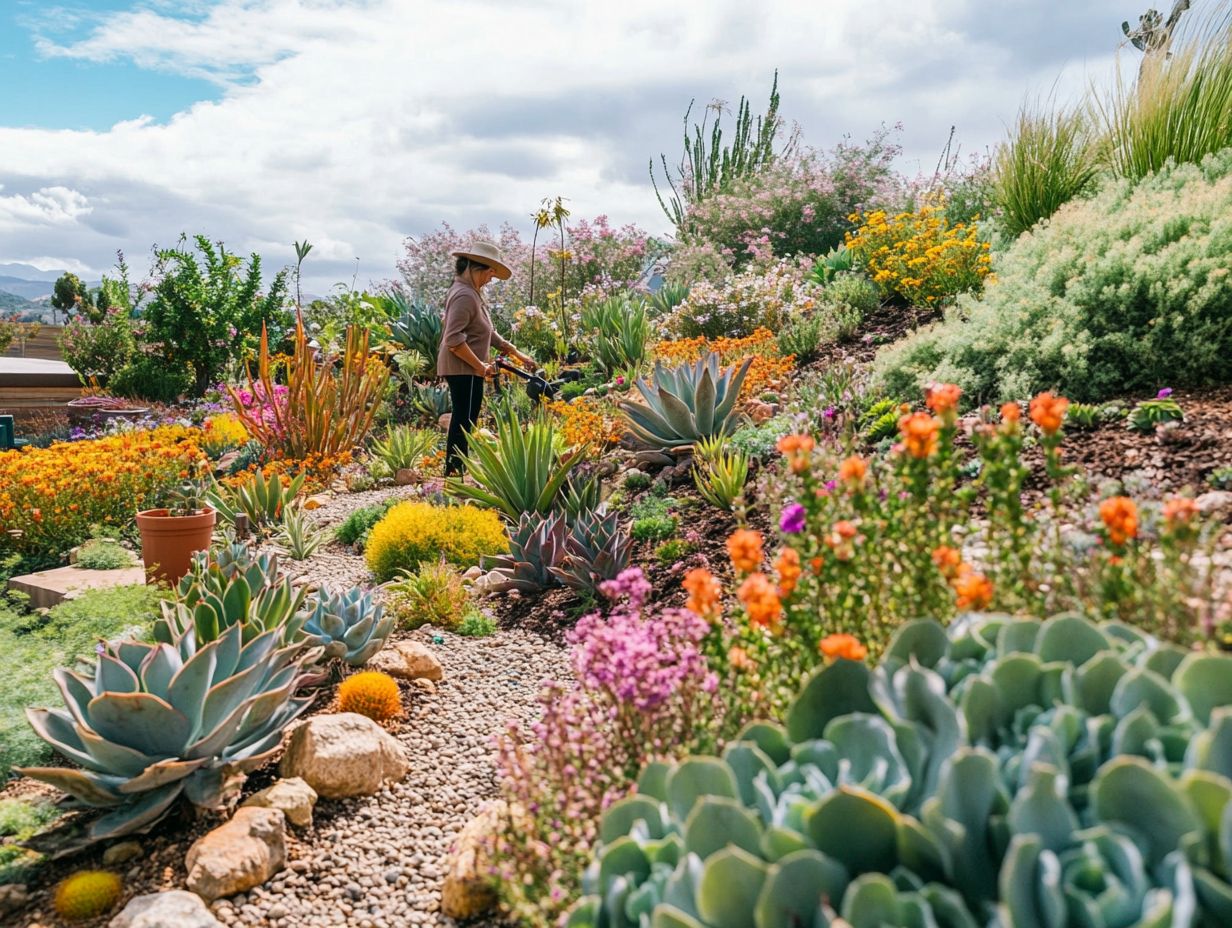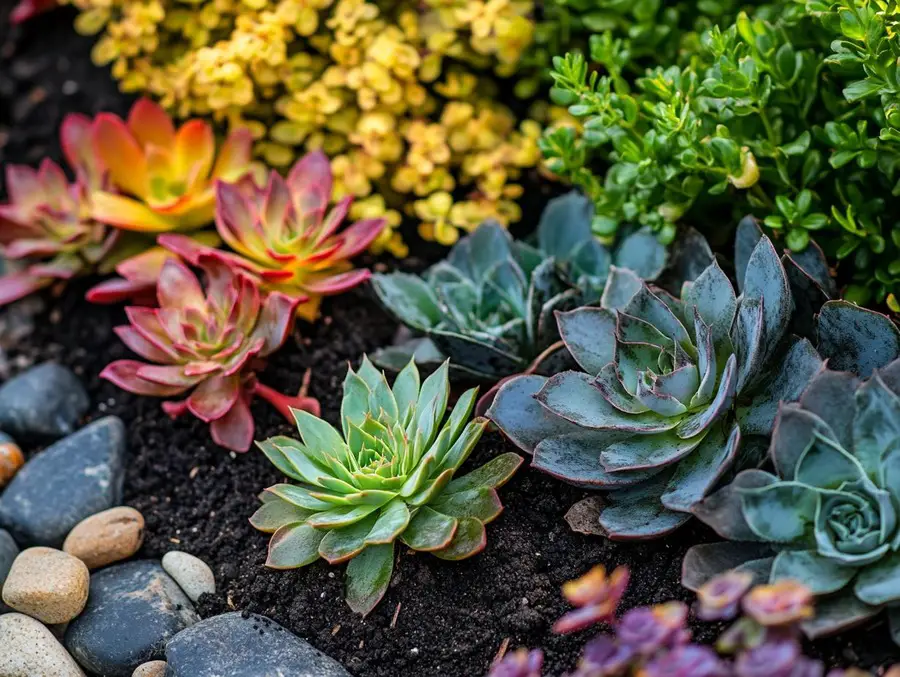We use affiliate links. If you purchase something using one of these links, we may receive compensation or commission.
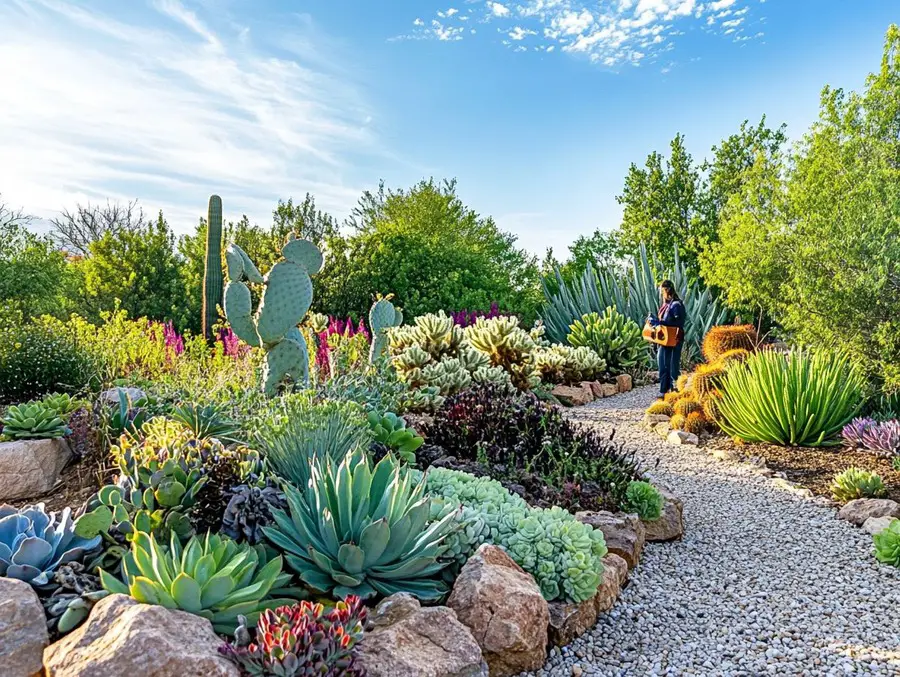
Pest control in xeriscape gardens is essential for keeping your drought-tolerant plants thriving.
Pests may be drawn to the resilience of xeric plants, causing damage if left unchecked.
The good news? With the right mix of natural predators, plant selection, and eco-friendly strategies, you can keep your xeriscape pest-free while maintaining a healthy, balanced ecosystem.
Pest Control in Xeriscape Gardens
Key Takeaways
- Pest control in xeriscape gardens involves using natural predators, pest-resistant plants, and organic solutions to protect drought-tolerant landscapes.
- Methods like companion planting, beneficial insects, and non-toxic sprays help maintain balance.
- Regular monitoring and targeted treatments prevent infestations, ensuring a thriving, sustainable garden without excessive chemical use.
Pest Control in Xeriscape Gardens: Keep Bugs Away Naturally
Xeriscape gardens, with their water-efficient designs and tough plants, can be a magnet for various pests.
While these gardens come with plenty of benefits, keeping them healthy and beautiful means you need some solid pest control strategies in your toolkit.
In this article, you’ll dive into the common pests that might threaten your xeriscape garden and ways to spot and manage these pesky nuisances.
You’ll also find both natural and chemical control options laid out for you.
Get ready to discover tips for prevention and learn how to handle infestations when they pop up, ensuring your garden thrives like it should.
The Importance of Pest Control in Xeriscape Gardens

Effective pest control in your xeriscape garden is essential for keeping your drought-tolerant plants healthy, maintaining good soil quality, and promoting a balanced ecosystem that supports beneficial insects and organic pest control methods.
Since water conservation is a top priority in these gardens, understanding how pests interact with your native plants is key.
This knowledge can help you create a vibrant environment bursting with plant diversity while reducing the need for chemical controls.
By using integrated pest management techniques, you protect your plants and boost the overall sustainability of your gardening efforts.
Understanding Xeriscaping and Its Benefits
Xeriscaping is a sustainable way to landscape that helps you reduce or even eliminate the need for irrigation.
By using drought-tolerant and native plants that thrive in arid climates, you can conserve water resources while making your garden look great.
This approach boosts the aesthetic value of your space, and it also promotes biodiversity and improves soil health, perfect for anyone who cares about the environment.
By incorporating strategies like smart plant placement, efficient irrigation techniques, and using mulch to keep moisture in, xeriscaping gives you a comprehensive way to manage your landscape in an eco-friendly way.
You’ll find that these techniques cut down on water use and also create resilient ecosystems that support local wildlife.
Using native species that are already adapted to your local climate means less maintenance for you.
This approach strengthens the bond between your garden and its surroundings while reducing your reliance on chemical fertilizers and pesticides.
Common Pests in Xeriscape Gardens
Understanding the common pests in your xeriscape garden is key to managing them effectively.
When you can identify pests early, you can significantly cut down on the damage to your plants and help promote a healthier garden ecosystem.
Seasonal pests like aphids, spider mites, and whiteflies can turn into a real headache if you’re not careful, so it’s super important to have a solid pest management plan ready.
This plan should include pest identification techniques and preventative measures that are tailored to fit the unique conditions of your garden.
Identifying and Managing Pests
Identifying and managing pests in your xeriscape garden starts with getting a handle on pest behavior and spotting the signs of an infestation.
Keep an eye out for unusual leaf damage or any changes in your plants’ health.
Using pest monitoring techniques, like scouting for seasonal pests and establishing threshold levels, will help you figure out the best pest control strategies to keep your garden healthy and balanced.
Make it a habit to observe your plants regularly.
This way, you can catch any issues early and act quickly.
Look for other signs like webbing, droppings, or even the pests themselves hanging around.
Adopting cultural practices, such as crop rotation and choosing resilient plant varieties, can help reduce the chances of pest outbreaks.
Regarding pest management, think about integrating a mix of strategies.
This includes biological controls, like inviting beneficial insects to your garden, and using environmentally friendly chemical treatments if they become necessary.
By understanding these elements, you’ll foster proactive management and promote the overall vitality of your xeriscape landscape.
Natural Pest Control Methods
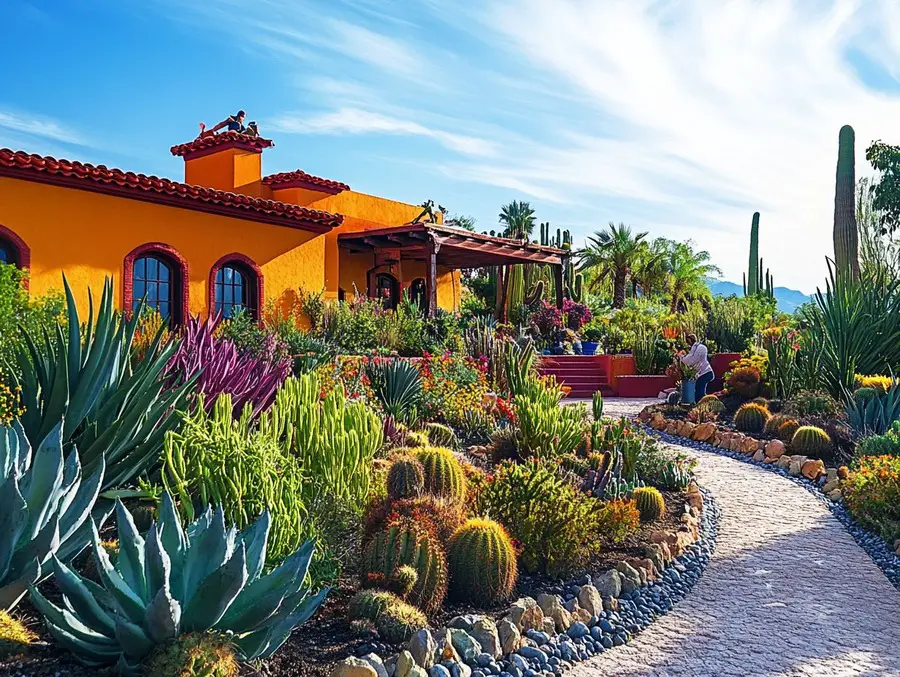
Natural pest control methods are a great way for you to manage pests in your xeriscape gardens while keeping things eco-friendly.
You can rely on beneficial insects, organic pest control solutions, and companion planting techniques to create a balanced ecosystem.
By creating a habitat for those natural predators and using pest-resistant plants, you can cut down on the need for chemical interventions and promote biodiversity in your outdoor space.
It’s a win-win for you and the environment!
Using Beneficial Insects and Plants
Utilizing beneficial insects and pest-resistant plants in your xeriscape garden can really make a difference in balancing the ecosystem.
You’ll find that it helps control pest populations naturally while keeping your plants healthy.
By using companion planting strategies, you can attract these natural predators, which will lend a hand in managing common pests like aphids and spider mites without having to resort to those harsh pesticides.
For example, introducing ladybugs and lacewings into your garden can be particularly effective.
These little guys are like the superheroes of pest control, munching on aphids and keeping their numbers in check before they wreak havoc.
When you choose plants like marigolds and yarrow, you’re not just beautifying your garden; you’re also repelling those unwanted insects.
These plants release natural compounds that deter pests while providing a cozy home for beneficial insects.
By creating a diverse plant community that supports these helpful critters, your xeriscape garden can flourish with better resilience against pests.
It’s a win-win situation, showcasing the amazing benefits of embracing natural solutions for pest control.
Chemical Pest Control Options
In your xeriscape garden, you’ll want to rely on natural pest control methods most of the time.
But there may be occasions when you need to bring in the big guns, like pesticides, especially if you’re dealing with a severe infestation that puts your plants at risk.
When that happens, it’s crucial to select products that are effective but also environmentally friendly.
Think about using organic pest control options or non-toxic solutions like insecticidal soap and essential oils to help keep your garden healthy while minimizing the ecological impact.
When to Consider Chemical Solutions
Knowing when to bring in chemical solutions for your pest management plan is key to reducing pest damage while keeping your xeriscape garden thriving.
By setting pest thresholds and regularly checking pest populations, you can figure out if you really need to go the chemical route or if natural methods can still do the job.
Keeping an eye on how much damage pests are causing is super important because it can seriously affect the health of your plants.
If you start noticing wilting leaves, discoloration, or stunted growth, it’s a pretty good sign that it’s time to step in.
By tracking population levels with regular inspections, you can spot trends that might hint at future outbreaks.
Integrated pest management shows that using a mix of strategies is the best way to go, helping you figure out the right time for any chemical interventions.
Using thresholds helps cut down on unnecessary chemical use and also makes sure that when you do take action, it’s timely and makes sense for your situation.
This holistic approach strikes a balance between caring for the environment and keeping your pest problem in check.
Tips for Preventing Pests in Xeriscape Gardens

To prevent pests in your xeriscape garden, you’ll want to take some proactive steps that boost soil health, support plant health, and make things less inviting for those unwanted visitors.
Techniques like mulching, encouraging a variety of plants, and choosing pest-resistant species will make your garden thrive and lower the chances of pesky infestations.
Maintaining a Healthy Garden Environment
Maintaining a healthy garden environment is key to your success with xeriscape gardening and it plays a big role in keeping pests at bay.
By making sure you have the right soil moisture, promoting a mix of plant varieties, and adding organic amendments, you can create a resilient ecosystem that naturally deters pests and boosts overall garden biodiversity.
This approach makes your garden look great but also enhances its sustainability.
Fostering a blend of native and drought-tolerant plants can improve the soil’s nutrient profile and its ability to retain water.
Using organic mulches and compost helps keep moisture levels up while providing those essential nutrients.
Integrating beneficial insects and practicing companion planting can help create a natural balance in your garden, reducing your reliance on chemical pesticides.
These practices promote healthier soils and contribute to a well-rounded ecosystem, leading to more robust plant growth and fewer pest problems.
Dealing with Pest Infestations
Dealing with pest infestations in your xeriscape garden can be a real challenge, but you can tackle it effectively with the right strategies and some timely pest monitoring.
Quick actions, like handpicking those pesky invaders, using reusable traps, and applying targeted pest control methods can make a big difference.
These steps will help you restore balance and keep your plants safe from serious infestations.
Steps to Take for Severe Pest Problems
When you’re dealing with severe pest problems in your xeriscape garden, it’s key to take a systematic approach guided by an integrated pest management plan.
This helps you minimize pest damage and protect the health of your plants.
Your plan should include regular pest monitoring, thorough identification of the pests, and the implementation of effective control strategies tailored to the specific issues you’re facing.
Start by keeping an eye on your garden regularly to spot any unusual activity early on.
Identifying the types of pests hanging out in your garden is crucial since it helps you assess the level of damage they might be causing to your plants.
Once you have a good grip on the pest species involved, evaluate how bad the infestation is and what impact it has on the overall health of your garden.
From there, you can decide whether to use natural deterrents, pesticides, or a mix of both.
Keeping a structured pest management plan tackles the current infestations but also prepares you to monitor future pest activity.
This way, your xeriscape garden can stay flourishing and resilient.
Pest Control in Xeriscape Gardens FAQs
What is pest control in xeriscape gardens?
Pest control in xeriscape gardens refers to the methods and techniques used to manage and prevent pests from causing harm or damage to plants and landscaping in drought-resistant, low-water gardens.
What are some common pests found in xeriscape gardens?
Common pests found in xeriscape gardens include aphids, whiteflies, spider mites, snails, slugs, and various types of beetles.
How can I prevent pests in my xeriscape garden?
To prevent pests in your xeriscape garden, it is important to choose plants that are resistant to pests and diseases, use proper spacing and irrigation techniques, and practice good garden hygiene by regularly removing dead plant matter and debris.
Are there natural methods for pest control in xeriscape gardens?
Yes, there are natural methods for pest control in xeriscape gardens, such as introducing beneficial insects, using homemade or store-bought organic pest control products, and creating a healthy ecosystem in the garden to discourage pests.
Can pesticides be used in xeriscape gardens?
Pesticides can be used in xeriscape gardens, but it is important to use them sparingly and only when necessary.
It is recommended to opt for organic and environmentally friendly pesticides to minimize harm to beneficial insects and wildlife.
What should I do if I have a severe pest infestation in my xeriscape garden?
If you have a severe pest infestation in your xeriscape garden, it is best to consult with a professional pest control service that specializes in eco-friendly and sustainable methods for pest control in xeriscape gardens.
Best Plants for Xeriscape Gardens: Hardy & Beautiful
Xeriscape Garden Styles: Easy Low-Maintenance Options
Xeriscape Gardening Techniques: Easy Low-Water Tips
Xeriscape Garden Design & Layout: Easy Water-Wise Beauty
What is xeriscaping? A beginner’s guide to drought-tolerant landscaping – Colorado State University
Related Content
Visit my Amazon Influencer Page for videos and gardening products Grow Your Own Garden

